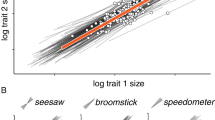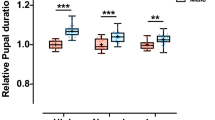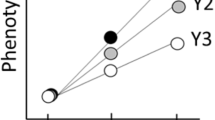Abstract
MATHER1 has shown that asymmetry of sternopleural chæta number in Drosophila melanogaster is subject to genetically controlled variation and is a valid measure of the capacity of the genotype to promote stabilization or canalization of the development of the individual. The following results show effects on asymmetry of X-chromosomes extracted from four different experimental populations.
This is a preview of subscription content, access via your institution
Access options
Subscribe to this journal
Receive 51 print issues and online access
$199.00 per year
only $3.90 per issue
Buy this article
- Purchase on Springer Link
- Instant access to full article PDF
Prices may be subject to local taxes which are calculated during checkout
Similar content being viewed by others
References
Mather, K., Heredity, 7, 297 (1953).
Tebb, G., and Thoday, J. M., Proc. XI Int. Genet. Cong. (in the press) (1953).
Mather, K., Biol. Rev., 18, 32 (1943).
Thoday, J. M., Symp. Soc. Exp. Biol., 8, 96 (1953).
Dobzhansky and Wallace, Proc. U.S. Nat. Acad. Sci., 39, 162 (1953).
Robertson, F. W., and Reeve, E. C. R., Nature, 170, 296 (1952).
Author information
Authors and Affiliations
Rights and permissions
About this article
Cite this article
TEBB, G., THODAY, J. Stability in Development and Relational Balance of X-Chromosomes in Drosophila melanogaster . Nature 174, 1109–1110 (1954). https://doi.org/10.1038/1741109a0
Issue Date:
DOI: https://doi.org/10.1038/1741109a0
This article is cited by
-
The genetic basis of developmental stability. I. Relationships between stability, heterozygosity and genomic coadaptation
Genetica (1993)
-
Fluctuating asymmetry and sexual selection
Genetica (1993)
-
Homeostasis, enzymatic heterozygosity and inbreeding depression in natural populations of Drosophila melanogaster
Genetica (1983)
-
Effets de la consanguinit� sur des caract�res morphologiques quantitatifs chez Culex pipiens autogenicus Roub.
Genetica (1982)
-
Fly size, emergence time and sternopleural chaeta number in Drosophila
Heredity (1961)
Comments
By submitting a comment you agree to abide by our Terms and Community Guidelines. If you find something abusive or that does not comply with our terms or guidelines please flag it as inappropriate.



